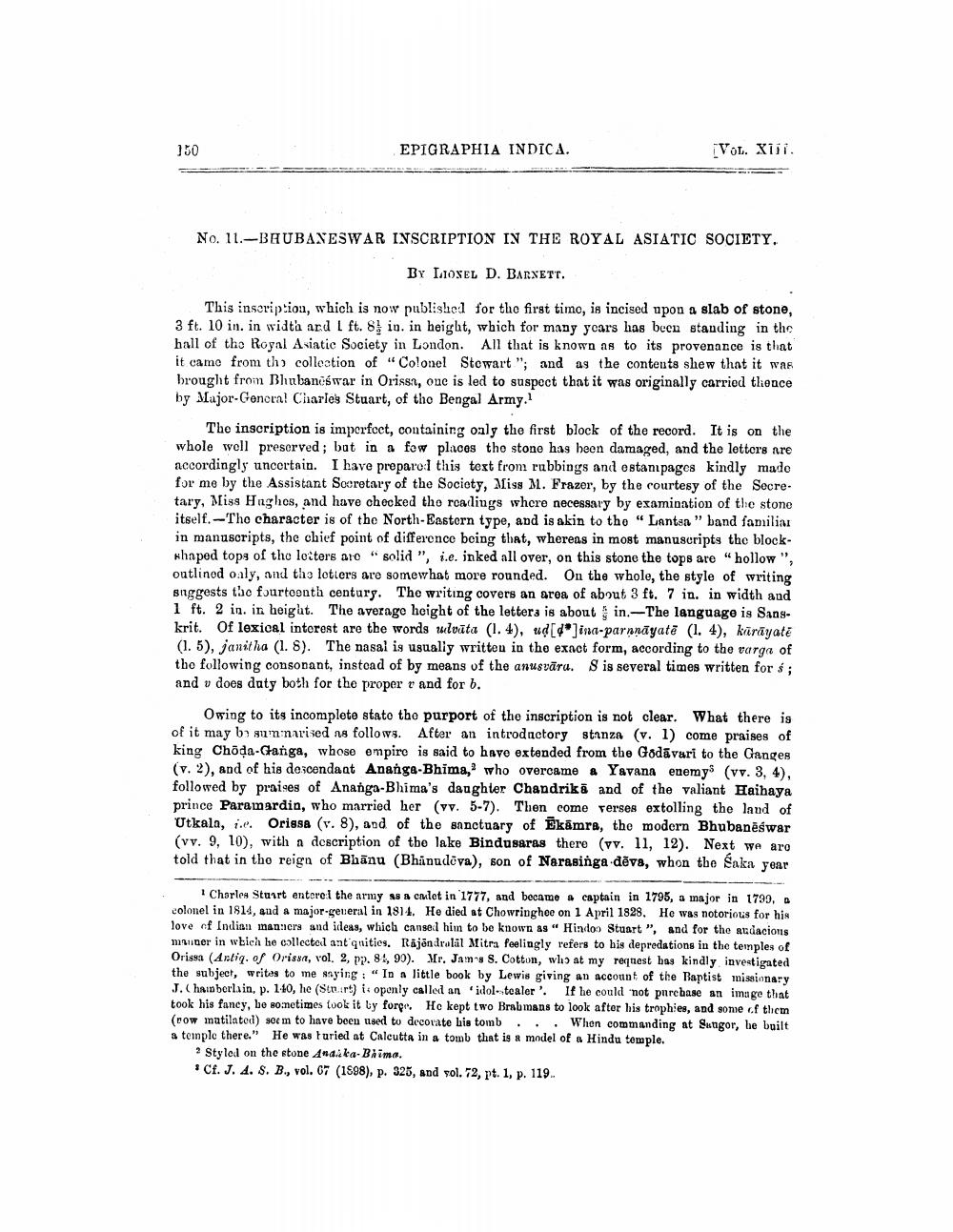________________
150
EPIGRAPHIA INDICA.
[Vol. Xui.
No. 11.-BHUBANESWAR INSCRIPTION IN THE ROYAL ASIATIC SOCIETY.
BY LIONEL D. BARNETT.
This inscription, which is now published for the first timo, is incised upon a slab of stone, 3 ft. 10 in. in widta ard ft. 8) in, in height, which for many years has been standing in the hall of the Royal Asiatic Society in London. All that is known as to its provenance is that it came from th collection of "Colonel Stewart "; and as the contents shew that it was brought from Bhubaneswar in Orissa, one is led to suspect that it was originally carried thience by Major-General Charles Stuart, of the Bengal Army.
The inscription is impcrfoct, containing only the first block of the record. It is on the whole well preserved; but in a fow places the stone has been damaged, and the letters nre accordingly uncertain. I have preparo: this text from rubbings and estampages kindly mado for me by the Assistant Secretary of the Society, Miss M. Frazer, by the courtesy of the Secre. tary, Miss Hughes, and have checked tho rcadings where necessary by examination of the stone itself.-The character is of the North-Eastern type, and is akin to the "Lantsa " band familiar in manuscripts, the chief point of difference being that, whereas in most manuscripts the blockshaped top of the loiters aro " solid ", i.e. inked all over, on this stone the tops are "hollow", outlined oaly, and the letters are somewhat more rounded. On the whole, the style of writing suggests the fourteenth century. The writing covers an area of about 3 ft. 7 in. in width and 1 ft. 2 in. in height. The average height of the letters is about in.-The language is Sangkrit. Of lexical interest are the words wlūta (1.4), ud[/]ina-parnnāyatë (1. 4), kārāyatë (1.5), janitha (1.8). The nasal is usually written in the exact form, according to the varga of the following consonant, instead of by means of the anusvāra. S is several times written for s; and v does daty both for the proper r and for b.
Owing to its incomplete stato tho purport of the inscription is not clear. What there is of it may bu gun narised as follows. After an introductory stanza (v. 1) come praises of king Choda-Ganga, whose empire is said to have extended from the Godavari to the Ganges (v. 2), and of his descendant Ananga-Bhima, who overcame a Yavana enemy (vv. 3, 4), followed by praises of Ananga-Bhima's daughter Chandrikā and of the valiant Haihaya prince Paramardin, who married her (vv. 5-7). Then come verses extolling the land of Utkala, ie. Origsa (v. 8), and of the sanctuary of Ekāmra, the modern Bhubanēswar (vv. 9, 10), with a description of the lake Bindusaras there (vv. 11, 12). Next we aro told that in tho reign of Bhānu (Bhanudova), son of Narasinga dēvs, whon tbe Saka year
Charles Stunrt entcrel the army ssa culet in 1777, and becamo #captain in 1795, a major in 1799, O colonel in 1914, and a major-general in 1814. He died at Chowringhoe on 1 April 1828. He was notorious for his love of Indian man:cra and ideas, which cansel him to be known as " Hindoo Stuart", and for the audacions miiber in which he collecteil antquities. Rájöndralal Mitra feelingly refers to his depredations in the temples of Orissa (Antiq. of Orissa, vol. 2, pp. 89, 90). Hr. James S. Cotton, who at my request has kindly investigated the subject, writes to me saying: "In a little book by Lewis giving an account of the Baptist missionary J.Chainberlain, p. 1.40, he (Sw.rt) is openly called an idol-tealer'. If he could not purchase an image that took his fancy, bo sometimes took it by forge. He kept two Brab mans to look after his trophies, and some of them (pow mutilated) som to have been used to decorate his tomb .. . When commanding at Sungor, be built a temple there." He was furied at Calcutta in a tomb that is a model of Hindu temple.
? Styled on the stone Andzka-Bima. . Cf. J. 4. S. B., vol. 67 (1998), p. 325, and vol. 72, pt. 1, p. 119.




